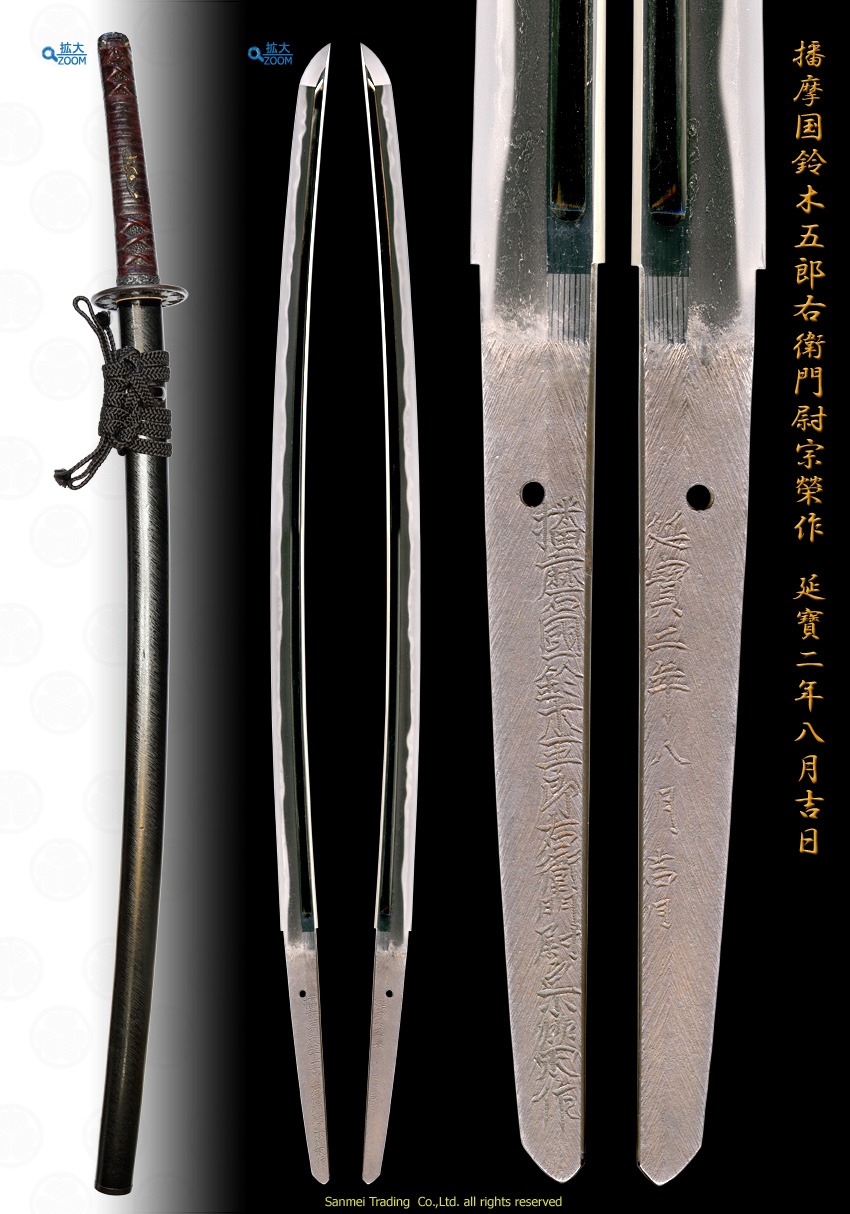S611142(S8898) Katana signed Harima-no-kuni Suzuki Goro-uemon-no-jō MUNEHIDE-saku
Auspicious day in the 8th month, Enpo 5th
with) SAMIDARE rain slanted notches lacquered scabbard Uchi-katana style Koshirae
Auspicious day in the 8th month, Enpo 5th
with) SAMIDARE rain slanted notches lacquered scabbard Uchi-katana style Koshirae
Length of cutting edge 74.1cm Curvature1.6cm Width of base31.6mm Width of Yokote22.6mm Thickness of base7.4mm
Forging(Hada): Forging mark is fine Ko-Itame. The superior made steel gives off clear Nie sparkling hard metal granules "Ji-nie" on Hira-ji surface and darkish lines of Nie so called "CHIKEI" activity that wells out from steel. "Yubashiri" - sparkling Nie granules appears on Hiraji of base.
Temper(Hamon): Hamon is fine Nie hard metal granules base, Notare-wavy, Gunome-midare and Choji (clove-outline) in general. Deep sparkling Nie accumulates on the gorges of Gunome-outline where interior is filled with mist-like crystallize area deeply with ASHI and floating YOU activities, thick lines of nie SUNAGASHI and bright curved threadlike KINSEN areas. The entire temper gives off the most flamboyant impression.
Temper of tip(Boshi): Temper of boshi forms Gunome below Yokote ridge then straight medium circle turns back in a good manner.
Tang(Nakago): Nakago is in UBU original. One peg hole. V-shaped(Taka-no-ha) filemarks. Back ridge of Nakago is well-rounded contours to show greatly slanting left file mark (O-sujikai). V-shaped (Kengyo) heel shape. The signature in front is fourteen character that starts from the place of work birth "Harima-koku" 播摩國 and his real name "Suzuki Goro" 鈴木五郎, an artistic official title Uemon-no-Jō 右衛門尉 then the smith name MUNEHIDE 宗榮.
The 1st generation smith MUNEHIDE 宗榮 who was active early Edo period, lived in Sakamoto-town, a couple of hundred meters northwest apart from Himeji castle (now a point on Green Hotel). The founder of MUNEHIDE 宗榮 was MUNENAGA 宗長 in Obama city, Wakasa province, who was invited during Tensho-Bunroku (1573-1592) to come to city of Himeji by the military commander Akamatsu Masahide 赤松政秀.
The smith MUNEHIDE initially lived at Chikusa, Shisou-gun where has been the most famous area of fine steel from ancient times.
The Himeji feudal lord Matsudaira Naonori 松平直矩 promoted him in recognition of his achievements to be an official sword maker under contract to the Himeji clan. After Matsudaira Naonori 松平直矩 was transferred to Bungo province on Keian 1st (1648), he was contracted to the Okayama feudal lord Ikeda Tsunamasa 池田綱政.
The subject katana is identified as the ealiest dates of year Enpo 5 (1677) inscribed on Nakago, onwards the date of years is recognized downs to Kyouho 5 (1720). The blade is longer and thicker than average, solidly heavy but well balanced blade by thick and wide bo-hi grooves carved on both sides. These would be the evidence to prove that this katana was carefully made in his prime on the special demand from high skilled Samurai class. In view of steel, it is understood that he carefully selected the top quality fine steel so called Chikusa-tetsu 千種鉄 to give off vividly clear and cool lights. Clear file marks of Nakago "V-shape" and energetic chiselled inscription of sign - these still remains an excellent condition for the age of 355 years.
SAMIDARE rain slanted notches lacquered scabbard Uchi-katana style Koshirae consists of : (click HERE for higher resolution images for each metal fitting)
Fuchi/kashira : a design of Waves, Shakudo ground, Takabori carving, gold Iroe inlay unsigned
Menuki : a design of Dragon, Yobori carving, gold Iroe inlay
Tsuka/hilt : Black lacquered rayskin, vermillion lacquered lozenge leather cord wrap.
Tsuba : a design of KIRI openwork, Iron ground, Silver Nunome-style inlay unsigned.
Seppa : Copper ground/gold foiled
Gold foiled double layers Habaki collar, Preserved in a Shira-Saya plain wood mounting.
Recent polish/Condition scale: mint-excellent (using a scale of mint-excellent-very good-good-fair-poor).
reference data : Honma Kunzan/Ishii Masakuni Ninto Meikan Yuzankaku 1975

